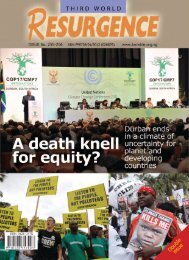Plantations, poverty and power - Critical Information Collective
Plantations, poverty and power - Critical Information Collective
Plantations, poverty and power - Critical Information Collective
You also want an ePaper? Increase the reach of your titles
YUMPU automatically turns print PDFs into web optimized ePapers that Google loves.
13<br />
Another reason for the move to the South is that energy is often cheaper there. Pulp production is<br />
extremely energy intensive. In Finl<strong>and</strong>, for example, the importance of cheap energy to the pulp <strong>and</strong><br />
paper industry is indicated by the fact that UPM-Kymmene <strong>and</strong> Stora Enso own shares in Pohjolan<br />
Voima, Finl<strong>and</strong>’s second biggest energy company. Pohjolan Voima is a major shareholder <strong>and</strong> founder of<br />
Teollisuuden Voima which is building the 1,600 MW Olkiluoto 3 nuclear plant. 27<br />
“Energy is the biggest single issue affecting the competitiveness of European industry today, including<br />
the paper industry”, notes Frits Beurskens, chairman of the Confederation of European Paper Industries<br />
(CEPI). 28 While the amount of energy needed to produce one tonne of pulp has declined in most countries<br />
in the North, the costs of energy have increased. 29 Although increases in the price of oil lead to increases<br />
in transportation costs, the transport costs of exporting pulp from, say, Uruguay to China is small<br />
compared to the costs of energy for pulp production.<br />
The major costs involved in pulp <strong>and</strong> paper production, apart from energy, are capital, fibre <strong>and</strong> labour.<br />
Trees grow faster in the South than in the North. Companies today can choose where they want to<br />
establish their plantations based on the growth rates of trees. The faster that trees grow in any particular<br />
country, the cheaper the fibre produced from the plantation. Decades of research <strong>and</strong> development into<br />
fast growing trees in plantations means that companies in Brazil are at the forefront of research into<br />
selecting species <strong>and</strong> managing industrial tree plantations. 30<br />
Meanwhile in many countries in the North, it is becoming increasingly unacceptable to continue logging<br />
on the scale that the timber <strong>and</strong> pulp industries would prefer. In Canada, for example, many accessible<br />
forest areas have been logged. Environmental protests <strong>and</strong> increased regulation has made it more difficult<br />
for the industry to continue destructive clearcutting (although clearcutting has not been eliminated). In<br />
Finl<strong>and</strong>, the industry faces protests against the logging of old-growth forests in northern Lapl<strong>and</strong>.<br />
Greenpeace has documented timber logged from old-growth forests arriving at Stora Enso’s Veitsiluoto<br />
paper mill. 31 In March 2007, Greenpeace protested at the Botnia pulp mill <strong>and</strong> the Stora Enso paper mill<br />
at Kemi in northern Finl<strong>and</strong>, dem<strong>and</strong>ing a stop to the destruction of ancient forests in Lapl<strong>and</strong>. 32<br />
September 2000. http://www.wrm.org.uy/bulletin/38/China.html<br />
27 Päivi Munter (2005) “Finl<strong>and</strong> stomachs nuclear growth”, Financial Times, 31 October 2005.<br />
Construction of the Olkiluoto 3 nuclear plant started in 2005. In 1986, Finl<strong>and</strong> was about to order a new nuclear<br />
<strong>power</strong> plant. The Chernobyl catastrophe put paid to those plans, for almost twenty years. Enrique Tessier (1989)<br />
“Exporters’ cause for concern - Problems for Finnish manufacturers”, Financial Times, 13 December 1989.<br />
28 Frits Beurskens (2007) “Editorial”, European Pulp <strong>and</strong> Paper, CEPI’s external newsletter, Issue 19, January/February<br />
2007.<br />
29 Adrian Whiteman (2005) “Recent trends <strong>and</strong> developments in global marNielsonkets for pulp <strong>and</strong> paper”, Paper presented<br />
at Paperex 2005 – International Technical Conference on Pulp <strong>and</strong> Paper Industry, 3-5 December 2005, New Delhi, India,<br />
page 42.<br />
30 Adrian Whiteman (2005) “Recent trends <strong>and</strong> developments in global markets for pulp <strong>and</strong> paper”, Paper presented at<br />
Paperex 2005 – International Technical Conference on Pulp <strong>and</strong> Paper Industry, 3-5 December 2005, New Delhi, India,<br />
page 3.<br />
31 “Stora Enso: pulping old-growth forests – old-growth forest wood route documented by Greenpeace, 10 January, 2007”,<br />
http://www.forestinfo.fi/forestlapl<strong>and</strong>/storaenso.html<br />
In January 2008, Greenpeace photographed clearcut old-growth forests in eastern Finl<strong>and</strong>. Trees up to 400 years old were<br />
logged. The wood was sold to Stora Enso’s pulp <strong>and</strong> paper mill in Oulu <strong>and</strong> to UPM’s paper mill in Kajaani.<br />
http://www.flickr.com/photos/greenpeacefinl<strong>and</strong>/sets/72157604007222744/<br />
32 “Greenpeace reveals that production of magazines <strong>and</strong> packaging linked to destruction of Europe’s last ancient forests”,<br />
Greenpeace, 22 March 2007. http://www.greenpeace.org/international/press/releases/greenpeace-reveals-that-produc















